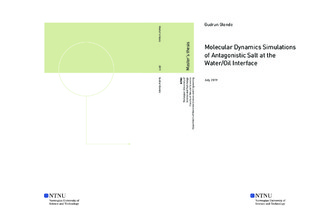| dc.contributor.advisor | de Wijn, Astrid | |
| dc.contributor.advisor | Pousaneh, Faezeh | |
| dc.contributor.author | Glende, Gudrun | |
| dc.date.accessioned | 2019-11-10T15:00:38Z | |
| dc.date.available | 2019-11-10T15:00:38Z | |
| dc.date.issued | 2019 | |
| dc.identifier.uri | http://hdl.handle.net/11250/2627531 | |
| dc.description.abstract | Blandinger av vann og organiske løsninger er veldig vanlig. De finnes i alt fra menneskekroppen til
flere industriprosesser. Ved høyere og lavere temperaturer vil en blanding, som består av vann og
den organiske løsningen 2,6-lutidin, forme en homogen fase. Mellom disse temperaturene vil det
formes et tofase-område, bestående av en vannfase og en organisk fase. Denne masteroppgaven
studerer variasjoner i spenning i tofase-området ved tilsetning av et antagonistisk salt.
Et antagonistisk salt er et salt som består av en hydrofil og en hydrofob del. Den hydrofile delen
er tiltrukket av vannet, og vil løses i vannfasen. Den hydrofobe delen blir derimot frastøtt av
vann, og vil ende opp i den organiske fasen. Saltet vil derfor befinne seg i grenseskillet mellom
de to fasene. Målet med denne masteroppgaven er å finne ut hvordan grensespenningen påvirkes
av tilsetningen av antagonistisk salt.
Dette ble gjort ved å konstruere syv blandinger bestående av vann og 2,6-lutidin med ulike
konsentrasjoner av salt. Systemene ble konstruert og simulert ved hjelp av molekylærdynamikk.
Resultatene av simuleringene viser at grensespenningen synker ettersom konsentrasjonen av salt
øker. I tillegg vises det at størrelsen på tofase-området minker når konsentrasjonen av salt øker,
og området kan forsvinne helt ved høyere konsentrasjoner. Et slikt system består da utelukkende
av en homogen fase. | |
| dc.description.abstract | Mixtures composed of water and organic solvents are very common. They are found inside
our bodies and in many industries. A mixture composed of water and the organic solvent 2,6-
lutidine is a uniform mixture at higher and lower temperatures. In the mid region the mixture will
separate into two phases, water and organic, and form a two-phase region. This thesis has studied
the variation of tension between the two phases when an antagonistic salt is introduced.
An antagonistic salt is a salt composed of a hydrophilic and a hydrophobic part. The hydrophilic
part is attracted to water, and dissolves in the water phase. The hydrophobic part is not attracted
to water, and ends up in the organic phase. Hence, the salt is located at the interface between
the two phases. The aim of this master’s thesis was to find out how the interfacial tension and
the size of the two-phased region were influenced by addition of antagonistic salt.
The work was conducted by preparing seven mixtures composed of water and the organic solvent,
with different concentrations of salt. The systems were constructed and simulated by means of
molecular dynamics simulations.
The simulated results showed that the interfacial tension decreases as concentration of salt increases.
Further, the results showed that the size of the two-phased region is reduced as the
concentrations of salt increases, and that the region completely disappears for higher concentrations.
The system then consists exclusively of a homogeneous phase. | |
| dc.language | eng | |
| dc.publisher | NTNU | |
| dc.title | Molecular Dynamics Simulations of Antagonistic Salt at the Water/Oil Interface | |
| dc.type | Master thesis | |
